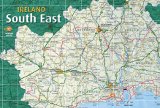South East Ireland Tourism
Travel guide to Ireland's south east
Travel guide to Ireland's south east
Wexford’s Top Historical Attractions
County Wexford can be found in the very south east corner of Ireland. It is a county steeped in history and heritage, much of which can be attributed to its strategic coastal location which attracted Celtic tribes, Vikings and Normans. Today, much of Wexford’s legacy remains to be seen in some spectacular historical sights. Here we take a look at just seven significant historical attractions in Wexford.
Today the fort is a major attraction and houses a maritime museum, a children’s museum, art galleries, a café and craft shop. Duncannon Fort holds a spectacular military re-enactment each year along with a vehicle show.
Today visitors to the lighthouse can take a guided tour and climb the 115 steps to the parapet and admire the breathtaking views of Waterford Harbour. The Lighthouse has a visitor centre which is open all year round.
Johnstown Estate comprises of 50 aces of beautiful gardens and also features lakes, waterfalls, terraced gardens, statues and over 200 different types of shrubs and trees. The castle itself is not open to the public but the gardens and museum are open all year round.
Today visitors can explore the ship and get a glimpse of what it was like for many Irish famine emigrants as they set out on a journey across the Atlantic in hope of a better life. This ship would be the home of the passengers and crew for 45 days until the boat docked in Boston! Take a tour of the ship and see the first class quarters, the crew’s quarters, the deck and lots more.
This award winning multi media and interactive visitor centre uses state of the art techniques and audio-visuals presentations to tell the story of each period of history in Ireland. Visitors can also see an extensive array for artefacts and like size figures of famous historical figures from 18th century Ireland.
The 1798 uprising in Ireland was one of the most bloodiest and widespread rebellions in Ireland’s modern history – if you would like to learn more about it visit the National 1798 Visitor Centre website.
There’s also a children’s playground, animal corner and a Granny’s kitchen where traditional Irish meals can be enjoyed by the open fire while listening to some traditional music.
<< Return to Wexford page
Duncannon Fort
Duncannon Fort is a spectacular star shaped fortress strategically situated on a cliff top overlooking Waterford Harbour. The fort was built in 1588 to guard the area from an expected attack by the Spanish Armada and to also protect merchant ships from pirates as they sailed into Waterford Harbour. The fort features an enclosure surrounded by a 30ft high dry moat.Today the fort is a major attraction and houses a maritime museum, a children’s museum, art galleries, a café and craft shop. Duncannon Fort holds a spectacular military re-enactment each year along with a vehicle show.
Hook Head Lighthouse
The Hook Head Lighthouse is the oldest lighthouse in Ireland and one of the oldest operating lighthouses in the world! The lighthouse was built in the early 13th century and although it was closed for a while in the 17th century it has been guiding sailors into Waterford Harbour for over 800 years!Today visitors to the lighthouse can take a guided tour and climb the 115 steps to the parapet and admire the breathtaking views of Waterford Harbour. The Lighthouse has a visitor centre which is open all year round.
JFK Homestead
New Ross is the ancestral home of President John F Kennedy. JFK’s great grandfather Patrick Kennedy was born in a little place called Dugganstown in New Ross. Patrick emigrated to America during the mass emigration of the Irish in the 19th century. His children and grandchildren were to become part of one of the most famous Irish-American families ever. The Kennedy Homestead celebrates this tie with those who left for America and those who were left behind and the Homestead is still run by the Kennedy family.Irish Agricultural Museum & Johnstown Castle
Johnstown Estate is home to Johnstown Castle and Gardens and the Irish Agricultural Museum and it can be found just a 10 minute drive from Wexford town. The agricultural museum is one of the top cultural institutions in Ireland and displays a wide range of farmyard artefacts and tools from a bygone era. There are also a number of exhibitions including a Great Famine Exhibition which depicts what life was like before, during and after the famine in Ireland. This museum is housed in the castle’s farmyard buildings and is open all year round.Johnstown Estate comprises of 50 aces of beautiful gardens and also features lakes, waterfalls, terraced gardens, statues and over 200 different types of shrubs and trees. The castle itself is not open to the public but the gardens and museum are open all year round.
Dunbrody Famine Ship
Located in the docks in the town of New Ross, the Dunbrody Famine Ship is a full sized exact replica of a 19th century famine ship. The original ‘Dunbrody’ famine ship was built in Quebec in 1845.Today visitors can explore the ship and get a glimpse of what it was like for many Irish famine emigrants as they set out on a journey across the Atlantic in hope of a better life. This ship would be the home of the passengers and crew for 45 days until the boat docked in Boston! Take a tour of the ship and see the first class quarters, the crew’s quarters, the deck and lots more.
1798 Centre
The National 1798 Centre is located in the town of Enniscorthy in Wexford and it really is a place not to miss if you want to find out more about Irish history, the epic 1798 rebellion and the rise of Irish democracy.This award winning multi media and interactive visitor centre uses state of the art techniques and audio-visuals presentations to tell the story of each period of history in Ireland. Visitors can also see an extensive array for artefacts and like size figures of famous historical figures from 18th century Ireland.
The 1798 uprising in Ireland was one of the most bloodiest and widespread rebellions in Ireland’s modern history – if you would like to learn more about it visit the National 1798 Visitor Centre website.
Yola Farmstead
Want to see how our Irish ancestors lived and worked in a bygone era? Yola Farmstead is set on 5 acres and has farm building and cottages which depict what life was like long before electricity when everything was done by hand. The farmstead features bygone farm machinery, a blacksmith’s forge, a working windmill and thatched cottages.There’s also a children’s playground, animal corner and a Granny’s kitchen where traditional Irish meals can be enjoyed by the open fire while listening to some traditional music.
<< Return to Wexford page






